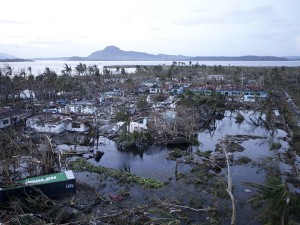Disaster experts warn on avoiding 2004 mistakes in Philippines

Tacloban City, devastated by powerful Typhoon Haiyan, is seen in Leyte province, central Philippines Saturday, Nov. 9, 2013. The central Philippine city of Tacloban was in ruins Saturday, a day after being ravaged by one of the strongest typhoons on record, as horrified residents spoke of storm surges as high as trees and authorities said they were expecting a “very high number of fatalities.” AP FILE PHOTO
SYDNEY – Disaster experts warned Monday that mistakes made in the relief effort after the catastrophic 2004 Indian Ocean tsunami must not be repeated with the super typhoon that has smashed the Philippines.
The humanitarian response to the tsunami, which left some 275,000 dead and wreaked havoc across Indonesia, India, Sri Lanka and Thailand nine years ago, sparked heated debate about the size, form and deployment of assistance.
Some observers, including the British Red Cross, complained that the relief effort was hampered by rivalries between agencies, delivery of inappropriate aid and difficulty in managing the huge sums of money donated.
Others said much of the reconstruction funding that was promised was never actually distributed, while money was squandered due to corruption, mismanagement, and unnecessary duplication of aid efforts.
Survivors of super typhoon “Yolanda” (international name: Haiyan), which is feared to have have killed more than 10,000 people – are growing increasingly desperate for aid and countries and organisations are scrambling to mobilise and donate.
But Martin Mulligan, chief investigator on an Australian research project conducted for AusAID on what could be learned from the post-tsunami recovery in Sri Lanka and southern India, said it was important to get it right this time.
“It is always the most vulnerable people who bear the brunt of such ferocious disasters and I’m not convinced that the disaster response ‘industry’ has learnt the lessons on how to rebuild devastated communities,” he said.
“The immediate post-tsunami relief effort was impressive but many mistakes were made – perhaps inevitably – in the targeting of aid for long-term social recovery,” he said.
“Aid organizations undoubtedly have more to learn from post-tsunami success stories about how to work within traumatised communities in order to ensure that aid funding is well targeted and effective.”
Paul Arbon, director of the government-run Torrens Resilience Institute in South Australia that was set up to improve the capacity of organizations to respond to disasters, agreed more thought must be put into the relief effort.
“Foremost, it is important that we make donations with thought and care,” he said.
“Typically, the well-meaning efforts of communities around the world result in an unmanageable influx of all kinds of goods into disaster zones and this creates a log jam in ports and airports that disables more targeted disaster relief.”
Arbon added that “the most difficult phase of disaster relief will occur over the coming months and years when communities will struggle to find the support that they need as the world’s attention moves on to the next disaster or crisis”.
On the ground in the Philippines, aid workers on Monday said the scene was one of utter devastation with millions of people affected.
“The devastation is beyond comprehension. We urgently need funds to meet the basic needs of children and their families,” said Save the Children chief executive Paul Ronalds, whose organisation has deployed rapid response teams to badly-hit Tacloban.
A humanitarian forum being held in Sydney this week, originally intended to look at the Syrian crisis, will now focus on the international response to the Philippines disaster with Australian Red Cross chief Robert Tickner Monday warning it will take years to rebuild.
“Whole communities smashed, horrific loss of life,” he said, adding that anyone who wanted to help should make a cash donation rather than sending goods, which may not be what is immediately needed.
“It’s better to buy locally and stimulate the local economy,” he said.